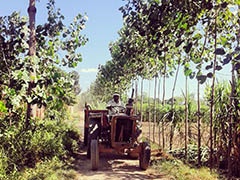The following post by IFPRI Director General Shenggen Fan was originally published on the World Food Day Network as part of their “Perspectives” series of essays on this year’s theme of family farming. This series is curated by the Food and Agriculture Organization of the United Nations (FAO) Liaison Office for North America.
Most smallholder farms are family-based and are a significant contributor to global food and nutrition security. But we should not translate this important role into the assertion that “small is always beautiful”. The appropriate development pathway for smallholder farmers depends on the level of economic transformation, including how diversified a country’s economy is. Smallholder family farms can prosper either through a “move up” or” move out” strategy.
Small is still beautiful in countries with a growing rural population and weak nonfarm growth, and these countries should work to advance policies that “move up” smallholder farmers in terms of increasing their productivity. This is the case in most countries in Africa south of the Sahara, where agriculture is responsible for a significant portion of economic output. Transforming economies, such as China and Vietnam, are those in which agriculture is being rapidly replaced by the manufacturing and service sectors, although poverty continues to be heavily concentrated in rural areas. Within this group, many smallholders can move out the agricultural sector to engage in urban and non-farm economic activities. Equally important is to help smallholders who remain in agriculture move up by promoting high-value agriculture and improving links to global and urban markets. Countries in South Asia like Bangladesh and India are between these two groups.
Smallholder farmers who remain in agriculture face a number of challenges such as climate change, price shocks, limited financing options, and inadequate access to healthy and nutritious food. By overcoming these challenges, smallholders can move from subsistence to commercially-oriented, more efficient agricultural systems and increase their incomes.
A number of critical measures are necessary to bring down barriers to profitable and efficient smallholder agricultural systems. A recent Food Policy Report by the International Food Policy Research Institute outlines six measures that are needed to develop a supportive policy environment for smallholder family farmers. First, policies should promote farm size based on the stage and structure of a country’s economic and demographic development. An especially critical policy is to promote efficient land markets, particularly rental markets, while protecting smallholders’ land rights. Second, increased support is needed to strengthen the ability of farmers to manage and mitigate risks such as volatile food prices and climate change. Efforts should include market-based price stabilization mechanisms and higher access to markets in developed countries. New technologies developed for smallholders should also be stress-tolerant against extreme weather events and adaptive to climate change. Third, productive and cross-sectoral social safety nets should combine long-term tools to enhance productivity with short-term social safety support for smallholders. Bangladesh, Brazil, Ethiopia, and Mexico have developed successful examples of cross-sectoral social protection initiatives that support a portfolio of productivity-enhancing investments. Fourth, a more integrated approach is needed to increase smallholders’ productivity and improve their nutrition and health status. Safety regulations and monitoring systems need to ensure that agricultural intensification does not harm people’s health; implemented without alienating smallholders. Fifth, increasing capital flows among smallholders requires innovative instruments that offer financial services to smallholders. Sixth, institutional arrangements should encourage the development and coexistence of various farming and coordination models (including cooperatives and individual family farms) that promote smallholder participation in increasingly sophisticated food value chains.
The vicious circle of vulnerability, low-yielding activities, and food insecurity among smallholders needs to be broken. While many smallholders can find more profitable livelihood opportunities outside of agriculture, others can be transformed into profitable and efficient agricultural businesses. However, this group of potentially profitable smallholder farmers needs a policy environment that supports and nurtures this transformation and helps them overcome the challenges they face.







